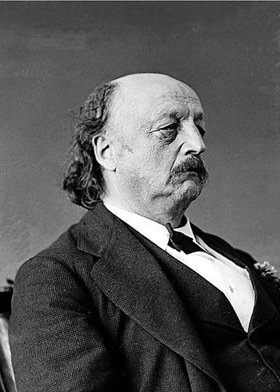
The Anti-Monopoly Party was founded as a national political party on May 14, 1884 at its convention at the Hershey Music Hall in Chicago. There were already Anti-Monopoly Parties at the state level, including in California and New York. The party advocated populist measures such as direct election of senators by popular vote, a graduated income tax, arbitration of industrial labor conflicts, establishment of labor bureaus to enhance the legal rights of organized labor, and antitrust legislation to break the power of the giant monopoly corporations that were emerging at the time. The party also opposed the use of protectionist tariffs and opposed granting of public land to railroads and other corporations.
There were 200 delegates from 16 states at the convention, including 61 from Illinois and Michigan.
Former U.S. Civil War general, congressman and Massachusetts governor Benjamin F. Butler, an advocate of civil rights and pro-worker policies, was nominated as the party’s candidate for president in the 1884 election. Butler received 175,370 votes. But the Anti-Monopoly Party did not exist for long after the election.
The People’s (also known as Populist) Party’s Omaha Platform, adopted in 1892, contained many planks of the Anti-Monopoly platform. Many political reforms first championed by the Anti-Monopoly Party and others were eventually enacted into law. Among them was direct election of senators, which became the 17th Amendment to the Constitution in 1913. The establishment of the National Labor Relations Board in 1935 can trace its roots back to the platform of the Anti-Monopoly Party.
Photo: Benjamin F. Butler, presidential candidate of the Anti-Monopoly Party in 1884. Wikipedia










